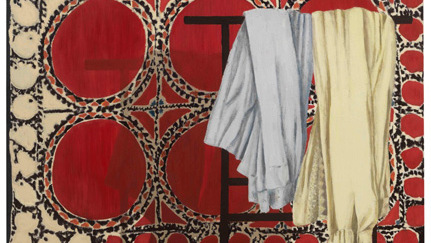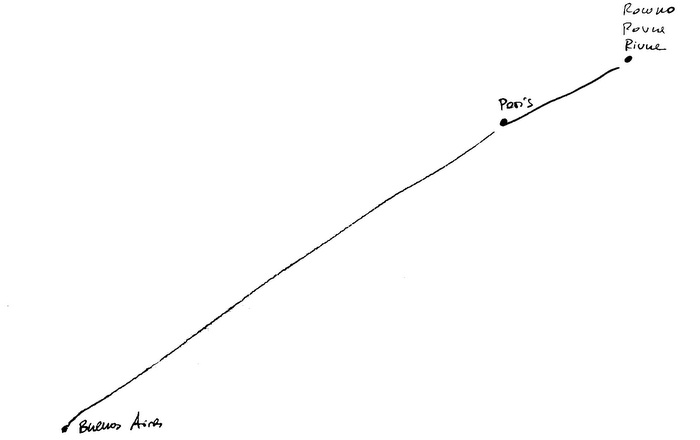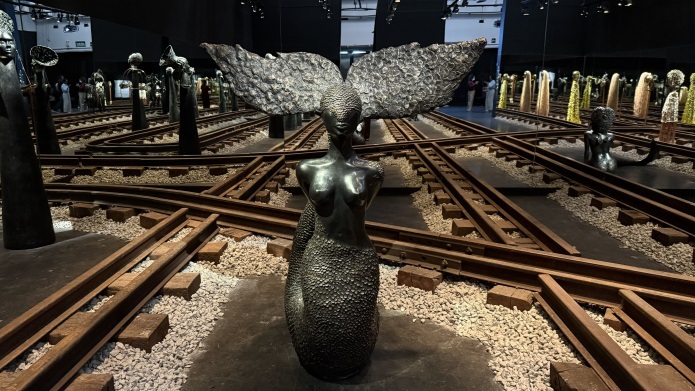David Zwirner is pleased to present an exhibition of new paintings by Swedish artist Mamma Andersson (b. 1962), on view at the gallery’s Paris location. Following her major 2021 solo presentation Humdrum Days at the Louisiana Museum, Humlebæk, Denmark, Adieu Maria Magdalena will be the artist’s first solo exhibition in Paris and her fifth with David Zwirner. In 2018, she was awarded the Daniel and Florence Guerlain Contemporary Art Foundation’s Drawing Prize.
Characterized by a unique combination of textured brushstrokes, loose washes, stark graphic lines, and evocative colors, Andersson’s works embody a new genre of painting that recalls late nineteenth-century Romanticism while also embracing a contemporary interest in layered, psychological compositions. Her often-panoramic scenes draw inspiration from a wide range of archival photographic source materials, filmic imagery, theater sets, and period interiors, as well as the sparse topography of northern Sweden, where she grew up: mountainous backdrops, trees, snow, and wooden cabins are recurrent elements within her works. Yet, rather than conveying specific spatial or temporal reference points, they revolve around the expression of atmospheres and subjective moods, and frequently appear to merge the past, the present, and the future.
The works in Adieu Maria Magdalena consider recurring themes and motifs from Andersson’s oeuvre and suggest complex and potent feelings related to loss. Marking a metaphorical farewell to a previous phase in her life, the exhibition title takes its name from a seventeenth-century church in the neighborhood where Andersson has long resided. The namesake painting portrays a screen divider with panels showing different views of uninhabited rooms; disembodied mannequin hands, a recurring motif for Andersson, are scattered at its base. Employing trompe l’oeil, the artist produces a subtly claustrophobic effect in this domestic space by layering uncanny interior scenes taken from her own home and her imagination, an interplay of surfaces and imagery that, like other works in the exhibition, probes the nature of representation.
Departing from earlier oil-on-board works, the paintings on view in Adieu Maria Magdalena primarily utilize canvas, a support that allows Andersson to create at a larger scale and expand compositional possibilities within the pictorial space. While these works evoke barren scenes by such artists as Vilhelm Hammershøi (1864–1916), they are also touched by Andersson’s personal and private associations that capture a sense of domesticity and quietude: the doll-like masks depicted in Behind the Masks (2023) include some she purchased and some gifted to her. Armageddon (2023) pictures a Suzani embroidery that hangs in Andersson’s home, with a clothing rack positioned in the bottom right corner. In three paintings of mirrors, the artist uses the guise of a reflective surface to show worlds of swirling ambiguity and spiritual and psychological depth. Instead of the expected reflections, mysterious landscapes appear encased in these elaborate antique gilded frames.
In several works in the exhibition, the artist continues to pay homage to Carl Fredrik Hill (1849–1911), a Swedish landscape painter who studied in France. Andersson’s own landscapes summon up Hill’s loose brushwork and variegated palette but are, by contrast, confined by elements of domestic architecture. In Quel Bordel (2023), a hallway—covered in a wallpaper illustrating fields and mountains—opens onto an enigmatic mise-en-scène, in which a small figure with its back toward the viewer shares space with a shelving unit that holds a pink female figurine and a horse. Other references entail visual experimentation, heightening the sense of dramatic tension: Andersson created certain paintings on a specially primed black canvas, bringing a varied surface quality to the work. Ohh, Deer (2023) dispels linear perspective: a wooden table, a mask, and a deer’s head float before a dark background. The composition loosely evokes traditional East Asian folding-screen painting, a genre that the artist has admired for many years.
Mamma Andersson was born in 1962 in Luleå, Sweden. She studied from 1986 to 1993 at the Kungl Konsthögskolan in Stockholm, where she continues to live and work.
Since 2004, Andersson has been represented by David Zwirner. The Lost Paradise, the artist’s fourth solo exhibition with the gallery, was on view in New York in 2020. Previous shows include Behind the Curtain (2015); Who is sleeping on my pillow (2010), a two-person exhibition with Jockum Nordström; and Rooms Under the Influence (2006), which marked the artist's United States debut.
The Kunsten Museum of Modern Art Aalborg, Denmark, organized the 2022–2023 exhibition, Tal R & Mamma Andersson–About Hill, which traveled to the Malmö Konstmuseum, Sweden, and will travel to Museum MORE, Gorssel, the Netherlands, in November 2023. In 2021, the Louisiana Museum of Modern Art, Humlebæk, Denmark, presented a solo exhibition of the artist’s work, Mamma Andersson: Humdrum Days. In 2018–2019, a solo presentation of Andersson’s work titled Memory Banks was on view at the Contemporary Arts Center in Cincinnati, Ohio. In 2011, the artist’s work was the subject of a solo exhibition at Museum Haus Esters in Krefeld, Germany. She had her first museum solo show in the United States at the Aspen Art Museum, Colorado, in 2010, and her first solo exhibition in Ireland at the Douglas Hyde Gallery, Dublin, in 2009. In 2007, a critically acclaimed mid-career survey of her work was organized by Moderna Museet, Stockholm, which traveled to Kunsthalle Helsinki and the Camden Arts Centre, London.
In 2018, she was awarded the eleventh edition of the Drawing Prize by the Daniel and Florence Guerlain Contemporary Art Foundation. For the 33rd Bienal de São Paulo in 2018, Andersson curated the group presentation Stargazer II, which featured a number of the artist's own paintings. In 2006, the artist won the Carnegie Art Award, a prestigious prize for Nordic contemporary painting, and received a corresponding exhibition that traveled extensively throughout Europe. Her work was represented in the Nordic Pavilion at the 50th Venice Biennale in 2003.
Forthcoming in fall 2023, David Zwirner Books will be publishing two titles in a series bringing together Andersson’s work and the writing of Karl Ove Knausgaard, which began with Mamma Andersson: The Lost Paradise (2021).
Work by the artist is represented in museum collections that include the Centre Georges Pompidou, Paris; Dallas Museum of Art; Göteborgs Konstmuseum, Gothenburg, Sweden; Hammer Museum, Los Angeles; Louisiana Museum of Modern Art, Humlebæk, Denmark; Magasin III, Stockholm; Malmö Konstmuseum, Sweden; Moderna Museet, Stockholm; The Museum of Contemporary Art, Los Angeles; The Museum of Modern Art, New York; National Public Art Council, Stockholm; San Francisco Museum of Modern Art; and Västerås Konstmuseum, Sweden.
Location
108, rue Vieille du Temple, Paris, 75003, France
Dates
October 16—November 18, 2023
On the cover: Image: Mamma Andersson, Armageddon, 2023
Source: David Zwirner















